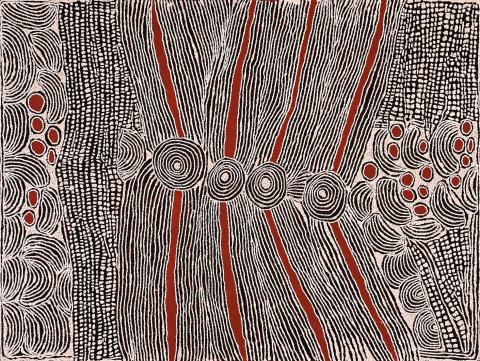WOMEN AT WIRRULNGA, 2005
NINGURA NAPURRULA
synthetic polymer paint on linen
183.0 x 244.0 cm
bears inscription verso: artist's name, size and Papunya Tula Artists cat. NN0510101
Papunya Tula Artists, Alice Springs
Suzanne O’Connell Gallery, Brisbane (label attached verso)
Private collection, Queensland
Deutscher and Hackett, Melbourne, 29 March 2009, lot 63
Private collection, Melbourne
A renowned Pintupi artist and one of the original Papunya painting women, Ningura Napurrula first painted in her own right in 1995, during the second year of a painting camp organised by women from Haasts Bluff and Kintore. She had developed her skills over many years assisting her husband Yala Yala Gibbs, a founding member of the Papunya Tula artists group, on his careful and meticulous Tingari Paintings. Within a year, Naparrula and many of the women from the camp were producing their own works, creating ‘some of the most radiant and richly textured surfaces in the history of the painting company…and helping to revitalize painting in the community after the deaths of many of the older group of painting men.’1
Naparrula’s body of work focuses not only upon her female ancestors, who traversed the country, creating sacred sites and establishing customs and ceremonies, but also features the everyday activities of women gathering bush tucker, giving birth, or the dancing and singing of ceremony, thus conveying her understanding of environment and tradition. Women at Wirrulnga, 2005 is a bold expression of country. The four roundels represent Wirrulnga, a waterhole site surrounded by small sand hills, found to the east of the Kiwirrkura Community in Western Australia. This place is important as a birthing site and Napaltjarri and Napurrula kinship groups are linked to the site. Pregnant women are represented by the lines next to the roundels. Rocky outcrops and sand hills are shown as grids and crescent shapes, respectively. At this site, women create hair-string skirts worn by the midwives and for ceremonies. The smaller roundels represent the berries collected by the women as they travelled north east to Wilkinkarra (Lake MacKay).
Napurrula held her first solo exhibition with William Mora in 2000, and the same year, she participated in creating the impressive and monumental Women’s collaborative painting for the Papunya Tula Genisis and Genius retrospective exhibition held at the Art Gallery of New South Wales. In 2003, Napurrula with four other artists was chosen to have a work depicted on an Australian Post postal stamp and the following year, she was selected as one of only eight Aboriginal artists to have her work included within the architectural design of the Musée du Quai Branly, Paris. Today her work is held in a number of significant public collections both throughout Australia and internationally, including the Art Gallery of New South Wales.
1. Johnson, V., ‘Seeing is Believing, A brief History of Papunya Tula Artists 1971 – 2000’ in Perkins, H. and Fink, H. (eds.), Papunya Tula, Genesis and Genius, Art Gallery of New South Wales, Sydney, 2000, p.197
CRISPIN GUTTERIDGE
